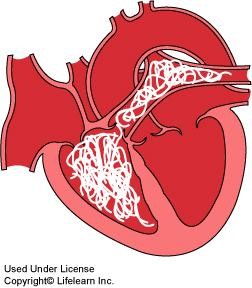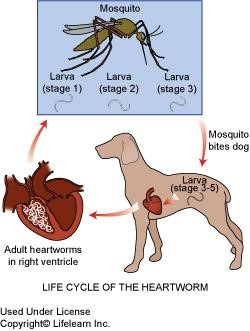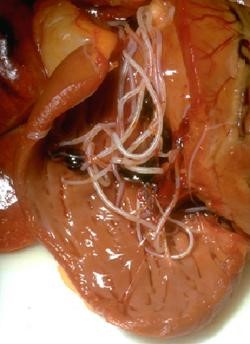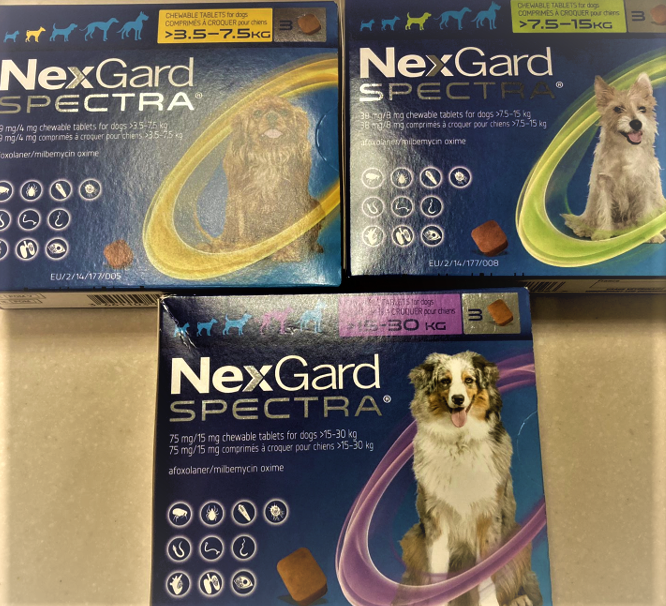What causes heartworm disease?
Heartworm disease or dirofilariasis is a serious and potentially fatal disease. It is caused by a blood-borne parasite known as Dirofilaria immitis.
Adult heartworms are found in the heart and adjacent large blood vessels of infected dogs. Rarely, worms may be found in other parts of the circulatory system. The female worm is 6 – 14″ long (15 – 36cm) and 1/8″ wide (5mm). The male is about half the size of the female. One dog may have as many as 300 worms present when diagnosed.

Adult heartworms may live up to five years and, during this time, the female produces millions of offspring called microfilaria. These microfilariae live mainly in the small vessels of the bloodstream.
What is the life cycle of the heartworm?
The life cycle of the heartworm is complicated; the parasite requires the mosquito as an intermediate host before it can complete its life cycle in the dog. As many as 30 species of mosquitoes can transmit heartworms.

The life cycle begins when a female mosquito bites an infected dog and ingests the microfilariae during a blood meal. The microfilariae develop further for 10 – 30 days in the mosquito’s gut and then enter its mouthparts. At this stage, they are infective larvae and can complete their maturation when they enter a dog.
The infective larvae enter the dog’s body when the mosquito bites the dog. They migrate into the bloodstream and move to the heart and adjacent blood vessels, maturing to adults, mating and reproducing microfilariae within 6 – 7 months.
What do heartworms do to the dog?
It usually takes several years before dogs show clinical signs of infection. Consequently, the disease is diagnosed mainly in two to eight year old dogs. The disease is rare in dogs less than one year of age because the microfilariae take five to seven months to mature into adult heartworms after infection. Unfortunately, by the time clinical signs are seen, the disease is usually well advanced.

Adult heartworms: Adult heartworms cause disease by clogging the heart and major blood vessels leading from the heart. They also interfere with the valve action in the heart. By clogging the main blood vessel, the blood supply to other organs of the body is reduced, particularly blood flow to the lungs, liver and kidneys, causing these organs to malfunction.
The signs of heartworm disease depend on the number of adult worms present, the location of the worms, the length of time the worms have been in the dog and the
degree of damage that has been sustained by the heart, lungs, liver and kidneys.
The most obvious clinical signs of heartworm disease are a soft, dry cough, shortness of breath, weakness, nervousness, listlessness and loss of stamina. All of these signs are most noticeable following exercise, when some dogs may even faint or become disoriented. Your veterinarian may notice abnormal lung and heart sounds when listening to the chest with a stethoscope. In advanced cases, congestive heart failure may be apparent and the abdomen and legs will swell from fluid accumulation. There may also be evidence of weight loss, poor condition, anemia and urinating “blood”. Severely infected dogs may die suddenly during exercise or excitement.
Microfilariae (immature heartworms): Microfilariae circulate throughout the body but remain primarily in the small blood vessels. Because they are about as wide as the small vessels, they may block blood flow in these vessels. The cells being supplied by these vessels are then deprived of the nutrients and oxygen normally supplied by the blood. Microfilariae primarily injure the lungs and liver. Destruction of lung tissue leads to coughing. Liver injury leads to cirrhosis of the liver, causing jaundice, anemia and generalized weakness. The kidneys may also be affected and allow toxins to accumulate in the body.
How is heartworm disease diagnosed?
In most cases, one or more simple blood tests will diagnose heartworm disease. Further diagnostic tests are essential to determine if the dog can safely undergo heartworm disease treatment. Some or all of the following diagnostic procedures are recommended before treatment is started:
Serological test for antigens to adult heartworms (antigen test, ELISA or SNAP test): This test is performed on a blood sample.
Blood test for microfilariae:
Like the “Hanging Drop” technique can identify microfilaria, further clarification is required. See the video below:
Other blood tests (CBC, blood chemistries, electrolytes): Abnormalities on the
complete blood count (CBC) and blood tests for kidney and liver function may
suggest the presence of heartworm disease.
Radiographs (X-rays): A radiograph of a dog with heartworms will usually show
heart enlargement and swelling of the large artery (pulmonary artery) leading to
the lungs from the heart. Radiographs may also reveal the condition of the heart,
lungs and pulmonary vessels.
Electrocardiogram (ECG): This test can also detect enlargements in heart
chamber size and help determine if a dog can safely undergo heartworm disease
treatment.
Echocardiography (ultrasound of the heart): An ultrasonic examination shows the
heart chambers allowing the general status of the heart to be evaluated. The
heartworms also be visualized.
How is heartworm disease treated?
There is some risk involved in treating dogs with heartworms, although fatalities are rare.
When some dogs are diagnosed, they have advanced heartworm disease. This means that the heartworms have been present long enough to cause substantial damage to the heart, lungs, blood vessels, kidneys and liver. A few of these cases will be so advanced that it will be safer to treat the organ damage rather than risk treatment to kill the heartworms. Dogs in this condition are not likely to live more than a few weeks or months. Your veterinarian will advise you on the best treatment approach for dogs diagnosed with advanced heartworm disease.
Treatment to kill adult heartworms:
An injectable drug to kill adult heartworms is given. It kills the adult heartworms in the heart and adjacent vessels. These injections may be divided and given thirty days apart. Your veterinarian will determine the specific injection schedule according to your dog’s condition. Many dogs will also be treated with an antibiotic to combat potential infection with bacteria (Wolbachia) that inhabit the heartworm.
Complete rest is essential after treatment. The adult worms die in a few days and start to decompose. As they break up ,they are carried to the lungs, where they lodge in the small blood vessels and are eventually reabsorbed by the body. This resorption can take several weeks to months and most post-treatment complications are caused by these fragments of dead heartworms. This can be a dangerous period so it is absolutely essential that the dog be kept as quiet as possible and is not allowed to exercise for one month following treatment. A cough is noticeable for seven to eight weeks after treatment in many heavily infected dogs. If the cough is severe, notify your veterinarian for treatment options.
Prompt treatment is essential if the dog has a significant reaction in the weeks following the initial treatment, although such reactions are rare. If a dog shows loss of appetite, shortness of breath, severe coughing, coughing up blood, fever or depression, you should notify your veterinarian.
Treatment to kill microfilaria: Approximately one month following treatment to kill the adults, the dog must return to the hospital for administration of a drug to kill the baby heartworms or microfilariae. Your dog may need to stay in the hospital for the day. Following treatment, your dog will be started on a heartworm preventative.
Are any other treatments necessary?
Dogs with severe heartworm disease may require antibiotics, pain relief medications, special diets, diuretics to remove fluid accumulations in the lungs, and drugs to improve heart function prior to treatment for the heartworms. Even after the heartworms have been killed, these dogs may require lifetime treatment for heart failure.
How can I prevent my dog from getting heartworms?
You can prevent your dog from getting heartworms by using a heartworm preventive. When a dog has been successfully treated for heartworms, it is essential to begin a heartworm prevention program to prevent future recurrence. With the safe and affordable heartworm preventives available today, no pet should ever have to endure this dreaded disease.

See the Canine Heartworm Society for further details:
https://www.heartwormsociety.org/veterinary-resources/american-heartworm-society-guidelines
Please consult your vet if you have any questions pertaining to the physical health of your dog!
This client information sheet is based on material written by: Ernest Ward, DVM
© Copyright 2009 Lifelearn Inc. Used and/or modified with permission under license.
http://balkanvets.com/index.php/tag/cardiology/







